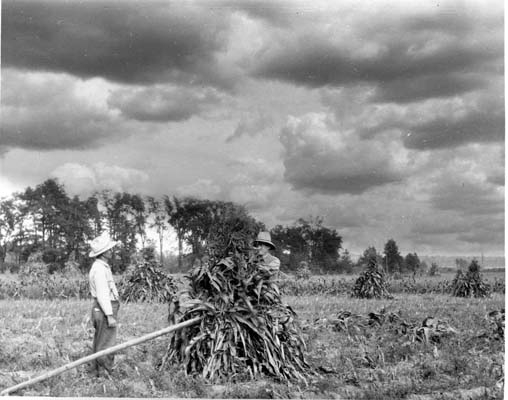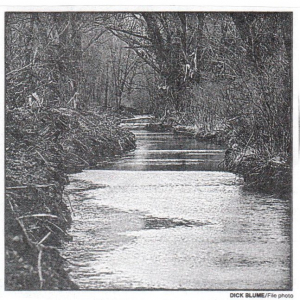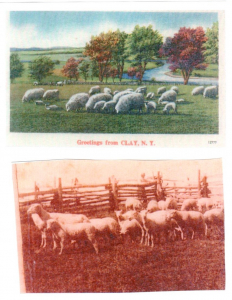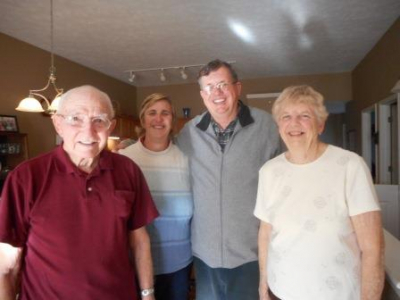Surviving on a Farm 100 Years AgoPosted on December 2, 2020 |
Image

|
HISTORY MYSTERY: Surviving on a Farm 100 Years Ago
The first photo shows corn being hay mown by hand with a sickle and in the second photo, corn is being shocked by hand. Carl Sotherden* will tell us some of his personal experience growing up as a young farmer.
“Even as young boys, I and my brother were soon driving the horses on the hay fork, one driving the team and the other handling the hay rope and “whiffletrees.” The next move was driving the team on the on the hay loader and as we stood on the front “gallus” of the hay wagon, we could get pretty well packed in and many hayseeds down our necks. Sometimes it seemed tha a tough-bited horse might pull our arms out of their sockets. By this time, we were expanding our operations somewhat and helping out grandfather who lived nearby growing tobacco, cabbage, potatoes and hay as cash crops. It seems each year we were learning to do new things and we would handle the lighter jobs, but as grandfather got older, he took them and we graduated to more physical labors.
“The first thing I remember about corn, we had three or four acres which were cut by hand with a corn sickle, shocked up with the aid of a corn jack, then left to dry in the shock for drawing late in the fall for hand husking. Some farmers had an old-fashioned bee, which turned out to be a gala social evening. The ears were fed to the pigs and chickens and some were ground up in the feed mixture for the horses and cattle.
“Changing methods of farming were taking place as I was growing up. At first, hay was cut by a horse-drawn mower with a five cutter bar, raked with a dump rake into windrows. It was then cocked up to cure for a few days before being pitched by hand to the barn and unloaded in the hay mow. As soon as I was large enough to reach the “hold down” pedal and the dump pedal, I began to do some of the raking. Dad fixed a foot rest on the mower so I had something to brace against to prevent being pulled off the seat as I drove the team. Generally there was a man with another team and mower working with me in case of trouble. This was later spoken of as “on the job training”.
“In the early days when the hay was handled lose, my dad drew quite a bit to Syracuse to the livery stables, the firehouses and to the market gardeners in the Buckley Road area, but hay loaders hitched behind the hay wagons became a reality. Then the field bailer came along. One season we hired a neighbor to bale some of our hay and dump it on the ground. This was heavy work by hand, so the next year we purchased a new field bale with a chute to run the bales directly from the baler on the rack and an elevator to run the bales into the mow. Baled hay took much less room to store and we even bought standing hay to fill the barn. It took a larger business to meet the expenses of more machinery.
“The oats and winter wheat we grew for our own use were cut by a drop reaper which had four wooden rakes to rake the cut grain off the wooden table in swaths. After laying out to dry, the grains were pitched with a tine long handled fork on a hay rack and put in a mow to await the arrival of the custom thrasher later that fall. This took an awful lot of time and energy so as soon as we deemed it profitable , we bought a used thrasher, which enabled us to save man hours and buy more land to expand. In a couple years we bought a new thrasher and did some thrashing for our neighbors. The next step was to buy a combine which saved even more hand labor.
“Our next big move in the way of progress was the erection of a 12 by 18 foot silo, which we filled the first year by a custom filler and this required a corn binder to bind the corn bundles to expedite handling. Some farmers only used a team of two horses on these binders, but Dad had a big heart for horses and we used a three-horse team, as well as for planting and dragging. I was taught early to regard the horses as our friends and to use them as such or as I would like to be used.
“Just to mention, the first custom thrashers and silo fillers used steam engines for power. The men had to bring along their own water tank to have enough water for the soft coal burning engine to provide steam and power. It took two men; one to constantly look after the engine to supply power, the other to feed the thrasher or silo filler. The engine man had to come early to get the fire going in the boiler and grease the machinery. Machinery was shut down once or twice a day for oiling. The first thrashers I remember were Fred Schell and Walter Hughson.”
*Memoirs of Carl Sotherden in his own words with my editing.
Dorothy Heller, Historian
10-29-2020
Other
History Mysteries
Cub Scout May 2012 Park Cleanup
History Mystery | May 1, 2012
Cub Scout 620 with the help of boy scouts and leaders cleaned the Clay Historic Park for the fourth year in a row. They raked leaves pulled weeds, picked up dead branches and cleaned flower beds.



